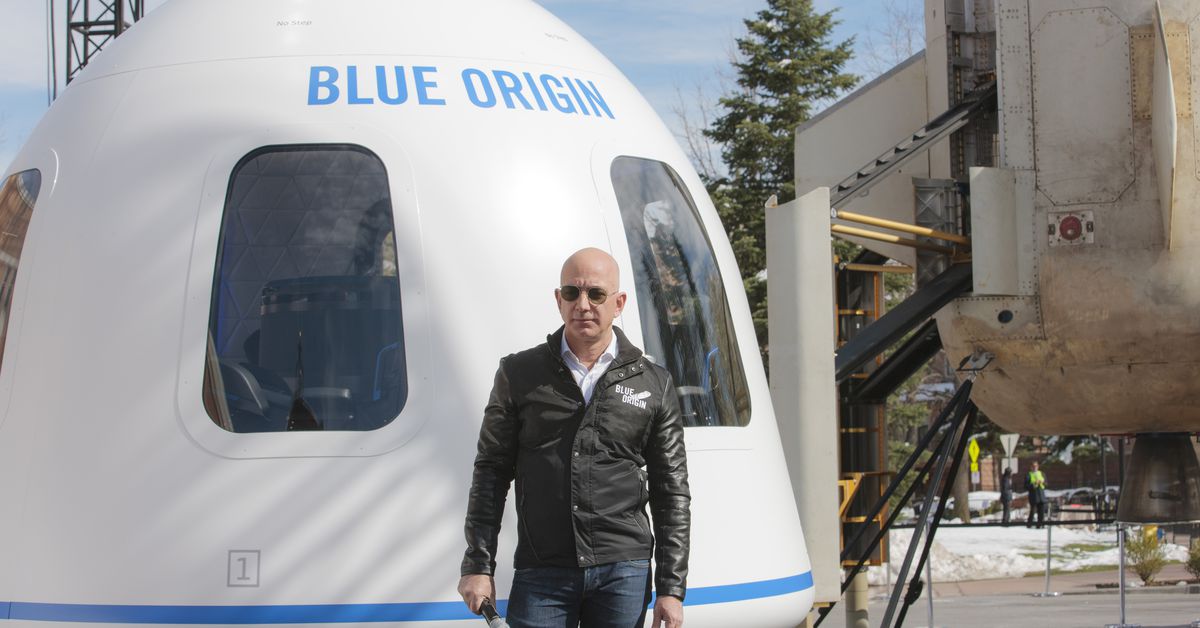Blue Origin targeting July for first crewed flight, opens auction for a seat
Source: The Verge added 05th May 2021Jeff Bezos’ space company Blue Origin is aiming to launch its first crew of humans to the edge of space on July 20th aboard its suborbital space tourism rocket, New Shepard, the company announced on Wednesday. One seat aboard that flight will be auctioned off to support its Club for the Future foundation.
“On July 20th, New Shepard will fly its first astronaut crew to space,” the company said in a press release. “We are offering one seat on this first flight to the winning bidder of Blue Origin’s online auction.” The auction starts today, the statement added, inviting the public to place a bid on its website. The statement didn’t include any information on how much each seat will cost going forward.
Blue Origin said the auction, managed by Massachusetts-based R&R Auction Company, will accept sealed, anonymous bids of any price until May 19th. Any bids after that will be visible to the public (and, of course, must exceed the highest bid to advance in the auction). Then there’ll be a live online auction on June 12th as a conclusion to determine the winning bidder.
Blue Origin made the announcement on the 60th anniversary of the first crewed American flight to space. The company’s first crewed flight will be the culmination of over a decade of rocket testing, which has been set back by delays — the company initially planned to start selling seat tickets in 2019, with a goal to fly its first crew in 2020.
According to the auction’s terms and conditions, the capsule for the debut crewed flight will be dubbed “RSS First Step Crew Capsule” and will include other astronauts picked by Blue Origin. The fine print doesn’t mention the July 20th launch date as mentioned in the press release, but says the flight “is expected to take place within six (6) months after the close of the Auction, and Blue Origin will keep the Astronaut updated as to changes to the date of the Flight.”
The fine print also listed physical requirements for the winning astronaut: passengers must weigh between 110 lbs and 223 lbs, and should be between five feet and six-foot-four inches tall. Passengers should also be able to take forces of up to 3Gs for a couple minutes during ascent (or up to three times their weight), and five-and-a-half times their weight (or 5.5gs) “for a few seconds during descent into the atmosphere.”
New Shepard — named after the first American to enter space, Alan Shepard — is a 60-foot-tall reusable launcher designed to shoot a gumdrop-shaped capsule with seats for six passengers to the edge of space, about 65 miles above ground. The suborbital rocket has successfully flown 15 tests since its first launch in 2015 but has never flown with a crew on board. Its most recent flight, in April, served as an “astronaut rehearsal for future customer flights.” Company executives roleplayed astronauts and ran through a bunch of pre-flight tests but left the capsule before liftoff.
The astronaut capsule is tailored for space tourists — each reclined seat gets its own massive window that stretches over three feet tall. The seats also come with their own push-to-talk buttons so passengers can chat with ground control, as well as tablet-sized screens fixed to the border of each window that shows live flight data and video from the launch.
Near the 65-mile altitude, the capsule separates from New Shepard, which begins its return to land guided by its single rocket engine. Meanwhile, the capsule spends about 10 minutes floating in microgravity where Earth’s atmosphere borders space. At that point, passengers can leave their seats and float around the capsule.
After basking in 10 minutes of weightlessness, the capsule starts to fall back to land, deploying a set of three parachutes to slow its return in the desert of Van Horn, Texas, a few miles from where New Shepard landed. Small rocket motors at the base of the capsule fire milliseconds before landing to soften the impact of touchdown. The capsule’s six seats are supported by a scissor-like mechanism that is designed to absorb the touchdown shock.
Developing…
brands: 110 Advance First Fixed Fly GumDrop New One other Recent SHOOT Space Tablet media: 'The Verge'
Related posts
Notice: Undefined variable: all_related in /var/www/vhosts/rondea.com/httpdocs/wp-content/themes/rondea-2-0/single-article.php on line 88
Notice: Undefined variable: all_related in /var/www/vhosts/rondea.com/httpdocs/wp-content/themes/rondea-2-0/single-article.php on line 88
Related Products
Notice: Undefined variable: all_related in /var/www/vhosts/rondea.com/httpdocs/wp-content/themes/rondea-2-0/single-article.php on line 91
Warning: Invalid argument supplied for foreach() in /var/www/vhosts/rondea.com/httpdocs/wp-content/themes/rondea-2-0/single-article.php on line 91
